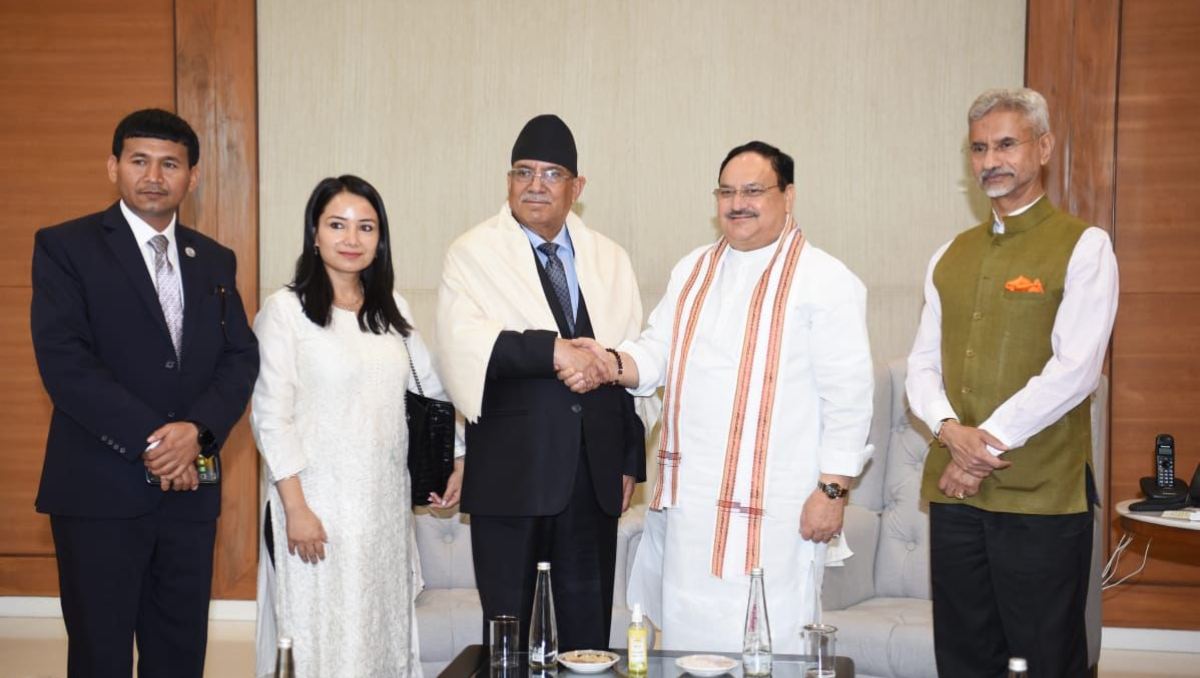As India’s and Nepal’s political parties and members are meeting, we can speculate on growing ties between the nation and their eagerness of working on new initiatives.Prachanda’s Visit to India

The India-Nepal bilateral ties are about to be strengthened as Prachanda visited India on the formal invitation of Jagat Prakash Nadda, the BJP President. Pushpa Kamal Dahal, popularly known as Prachanda accepted the invite for a three-day visit to India as stated by Ramesh Malla, Chief Personal Secretary of Prachanda.
The meeting’s relevance and importance were elevated by the presence of S. Jaishankar, the External Affairs Minister of India, and Ajit Doval, Indian National Security Advisor. The initiative was an important part of the ‘Know-BJP’ drive, to enhance party-to-party ties for curating mutual benefit programs. This meeting was after three-months after the present PM, Sher Bahadur Deuba’s visit.
Prachanda is a key partner and ally of the present government’s coalition. The discussions of the visit are expected to be a strong reflection of Kathmandu’s expectations.
The loopholes in the Treaty of 1950:
The treaty was endorsed and authenticated when the world was facing the Cold war and its effects. The important of Nepal was becoming important for India, because of its geographical location to China-occupied Tibet. At the same time, there was an internal struggle against the Rana rulers in Nepal.
The provisions of the treaty were founded on mutual socio-economic necessities, along with the unrestricted movement of people across open borders. It also stated that the citizens of both countries could freely participate in economic and industrial developments. The most striking clause was about the first preference of Indians in Nepal for its natural resources, which can be further used in developmental projects.
The first nail in the coffin of Indo-Nepal relations was a misunderstanding, that was overtly expressed in 1959, over the leaking of details from confidential documents. Then, there was dissatisfaction over the signatories Mohan Shamsher Jung Bahadur Rana, the Nepali King, and Chandreshwar Narayan Singh, the Indian Ambassador. This was because there was a mismatch in their titular positions.
Since then, timely, the treaty is under scrutiny by the Nepali side in finding faults in various articles. Contradictions were found in equal rights for citizens in job opportunities, residence, and acquisition of property in each other’s territories.
Post-1980s, both countries failed in following the Treaty.
The Current Scenarios: Prachanda’s Visit to India
The last decade of Indo-Nepal ties was full of reviewing of treaties. Both countries witnessed a crucial economic blockade in 2015. India had already learned about China’s growing presence in Nepal. In 2016, India agreed to re-evaluate, and then the Eminent Persons Group (EPG) meetings were scheduled. The meetings were conducted with the mandate of serious deliberations.
On one hand, India and Nepal faced border disputes because of the Kalapani map of 2019. While on the other hand, the Nepal-China meetings for the Nepal-China Rail link, industrial park, and Himalayan Multidimensional Connectivity network were successful.
Nepal is completely aware of the ‘Neighborhood First Policy’ and the benefits that Nepal has reaped. Nepal is aware of the multilateral developments of recent times in South Asia. Be it the Bangladesh-Bhutan-India-Nepal (BBIN) transport and economic corridor or the Bay of Bengal Initiative for Multi-Sectoral Technical and Economic Cooperation (BIMSTEC), equal partnership with India is necessary.
There are projects like the Janakpur-Ayodhya twin city project agreement, which are stalled due to a ‘lack of political will from both the nations.’ Prachanda’s visit indicates bringing a solution to the stagnant segments of the bilateral connectivity projects and initiatives.
The current leaders want to continue communications with each other and support each other’s powers for their benefit. In Nepal, where the governments change more often, BJP’s support is very crucial; specially to keep a check on the Southern part of Nepal that borders India.
Nepal’s stakes are higher in zeal and enthusiasm because of its current geographical role and position. We can look forward to the fruitful and productive ripening of such bilateral exchanges.













